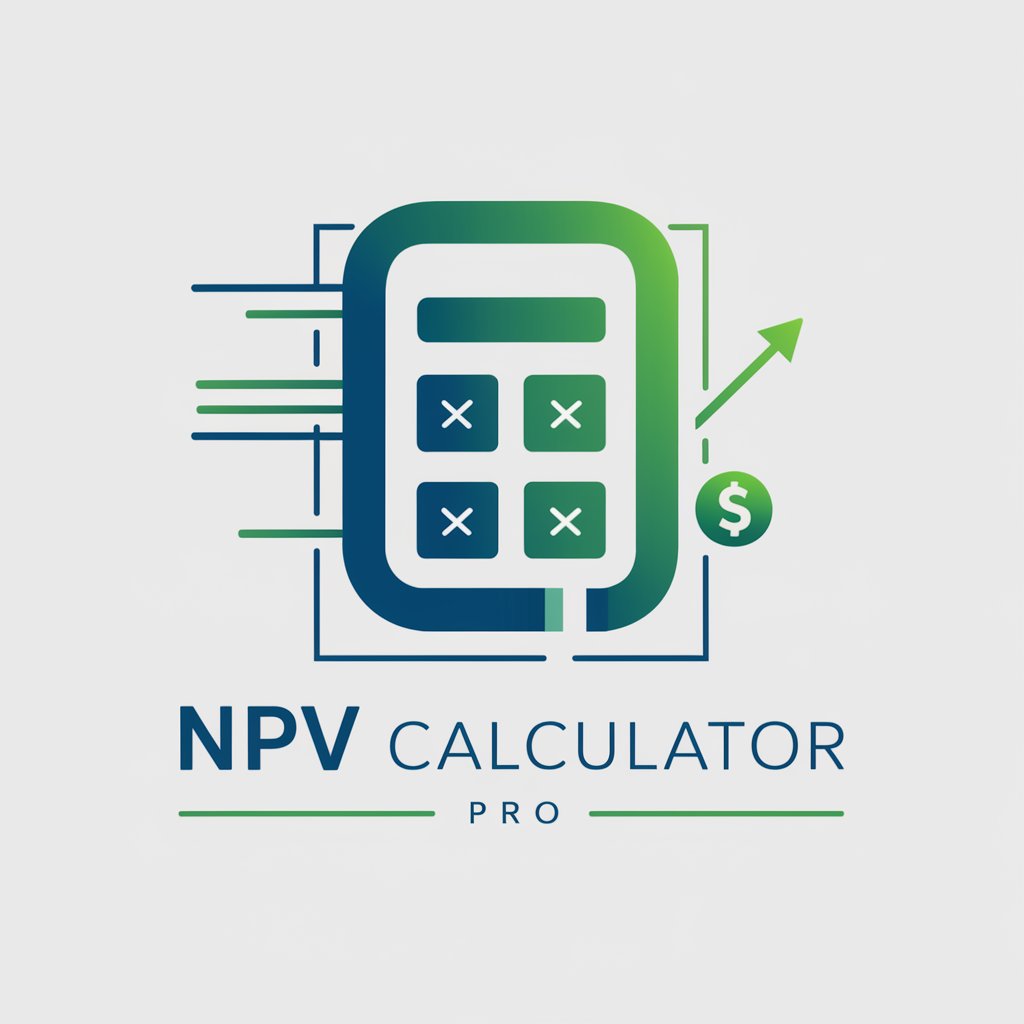Net Present Value (NPV) - NPV Calculation Tool

Welcome to NPV Calculator Pro, your reliable investment analysis tool.
Empowering Investment Decisions with AI
Calculate the NPV for a project with...
What is the net present value if...
Evaluate the profitability of an investment with...
Analyze the cash flows for a project that...
Get Embed Code
Introduction to Net Present Value (NPV)
Net Present Value (NPV) is a financial metric used to evaluate the profitability of an investment or project. It represents the difference between the present value of cash inflows and the present value of cash outflows over a period of time. NPV is a cornerstone of financial analysis and investment appraisal, helping investors and businesses make informed decisions by assessing the value of future cash flows in today's terms. A positive NPV indicates that the projected earnings, discounted for its present value, exceed the current investment cost, suggesting that the project is financially viable. For example, if an investor is considering investing in a new manufacturing plant, calculating the NPV of the expected cash flows from the plant operations, minus the initial investment cost, would provide a clear picture of the project's potential profitability. Powered by ChatGPT-4o。

Main Functions of Net Present Value (NPV)
Investment Appraisal
Example
Evaluating the viability of launching a new product line.
Scenario
A company estimates the future cash flows from sales of the new product and discounts them to present value. Comparing this against the initial investment costs helps decide whether the new product line should be pursued.
Project Selection
Example
Choosing between multiple project options with limited resources.
Scenario
A business evaluates several projects by calculating the NPV for each. The projects with the highest positive NPVs are prioritized, ensuring resources are allocated to the most profitable ventures.
Financial Planning
Example
Determining the feasibility of expanding operations to a new geographical market.
Scenario
Before expansion, a detailed NPV analysis predicts the net cash flows from entering the new market, considering both the setup costs and the expected revenue streams, to assess if the venture aligns with long-term financial goals.
Risk Assessment
Example
Analyzing the sensitivity of an investment's profitability to changes in key assumptions.
Scenario
By adjusting the discount rate or future cash flow projections, companies can use NPV to gauge how changes in market conditions or costs might affect the viability of an investment, aiding in risk management.
Ideal Users of Net Present Value (NPV) Services
Corporate Finance Professionals
These users regularly engage in complex financial modeling and investment analysis to guide corporate investment decisions and strategy, making NPV calculations an indispensable tool for evaluating project and investment profitability.
Small Business Owners
For small business owners, understanding the NPV of potential investments or expansions can be crucial in making informed decisions that affect the future of their business, especially when resources are limited.
Investment Analysts
Analysts use NPV to assess the value of stocks, bonds, and other securities by forecasting future cash flows and discounting them to present value, helping to inform buy, hold, or sell recommendations.
Project Managers
Project managers utilize NPV to prioritize projects based on their profitability, ensuring that capital and resources are allocated to projects that are expected to deliver the highest returns.

How to Use Net Present Value (NPV)
Initiate Trial
Begin by exploring NPV tools online for an initial experience without the need for registration or subscription, akin to visiting yeschat.ai for a complimentary trial.
Understand Cash Flows
Grasp the basics of cash flows, distinguishing between incoming and outgoing cash over the project's life. This knowledge is crucial for accurate NPV calculation.
Determine Discount Rate
Identify the appropriate discount rate for your project, which reflects the investment's risk and the cost of capital. This rate is pivotal in discounting future cash flows.
Calculate NPV
Utilize NPV calculation tools by inputting the expected cash flows and discount rate. This process will yield the NPV, indicating the project's value in today's terms.
Analyze Results
Interpret the NPV result to make informed decisions. A positive NPV suggests a potentially profitable investment, while a negative NPV indicates the opposite.
Try other advanced and practical GPTs
Boilers
Powering Industries with AI-Enhanced Heat

Best Selling
Empower your shopping with AI insights.

Pitch Deck Pro
Enhance Your Pitch with AI-Powered Insights

Sébastien Belle : Consultant en Ligne
Empowering Digital Transformation with AI

Strategic Tweet GPT
Craft tweets with AI-powered precision.

맛집 Master
Discover the Best Eats, Powered by AI

" Personal Lawyer"
Empowering Legal Decisions with AI

eCommerce Fulfilment James and James GPT
Empower Your Ecommerce with AI-Powered Fulfilment Insights

Fluffy Chaos Friends
Bringing fantastical creatures to life with AI.

SamenStromen Blogs
Empowering Energy Futures with AI

Offer Analyst
Enhance Your Offers with AI-Powered Insights

小红书风格爆款标题生成器
Empower Your Posts with AI-Powered Titles

Frequently Asked Questions About NPV
What is NPV and why is it important?
Net Present Value (NPV) is a financial metric used to evaluate the profitability of an investment or project by calculating the present value of expected future cash flows, discounted back to their present value. It's crucial for assessing investment opportunities, guiding capital allocation decisions.
How do you determine the appropriate discount rate for NPV calculations?
The discount rate reflects the investment's risk and opportunity cost of capital. It's often derived from the weighted average cost of capital (WACC), expected inflation, and the specific risk premium associated with the project.
Can NPV be negative, and what does that mean?
Yes, an NPV can be negative, indicating that the project's expected cash flows, once discounted, are less than the initial investment. This suggests the project may not be a worthwhile investment.
How does NPV compare to other investment appraisal methods?
NPV offers a more comprehensive analysis than methods like payback period or internal rate of return (IRR) by considering the time value of money and providing a dollar-value outcome, facilitating direct comparison between projects.
Is NPV applicable for both large and small-scale investments?
Absolutely, NPV is a versatile metric that can be applied across various scales of investments. It aids in evaluating the profitability and financial viability of any project, regardless of size, by accounting for the time value of money.
